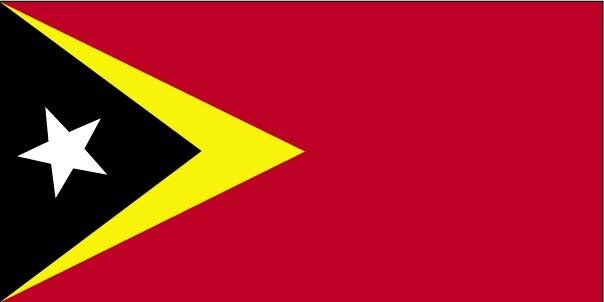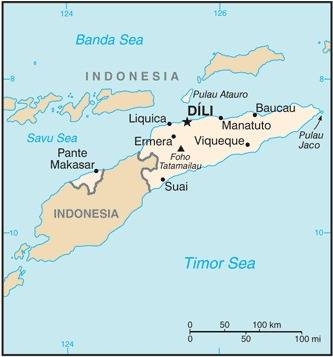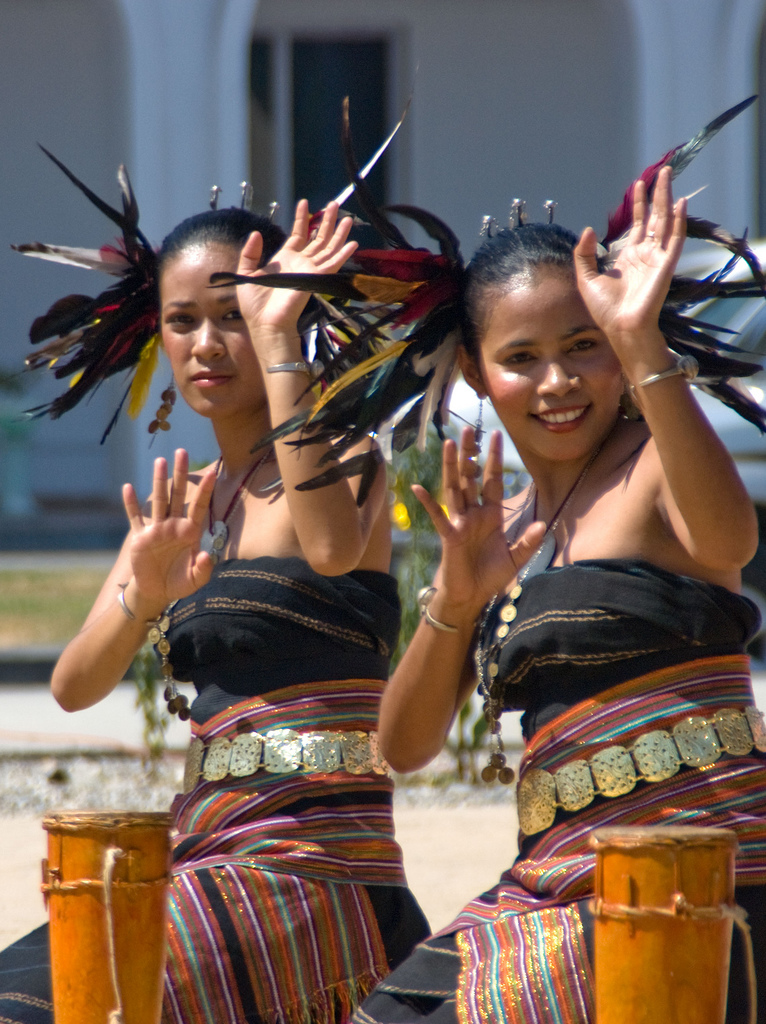170 Timor-Leste

Red with a black isosceles triangle (based on the hoist side) superimposed on a slightly longer yellow arrowhead that extends to the center of the flag. A white star – pointing to the upper hoist-side corner of the flag – is in the center of the black triangle. Yellow denotes the colonialism in Timor-Leste’s past, black represents the obscurantism that needs to be overcome, red stands for the national liberation struggle. The white star symbolizes peace and serves as a guiding light.
Flag courtesy of the CIA World Factbook

Map courtesy of the CIA World Factbook

Traditional Timorese dancers
Government
According to Britannica, the Portuguese first settled on Timor in 1520, and the Spanish arrived in 1522. The Dutch took possession of the western portion of the island in 1613. The British governed the island in 1812–15. The Dutch and the Portuguese fought for supremacy over Timor, and Portuguese sovereignty over the island’s eastern half was settled by treaties in 1860 and 1893, although the latter became effective only in 1914. Japanese forces occupied Timor during World War II. East Timor province, including the Ambeno enclave, thereafter remained in Portuguese possession until 1975, when one of the major political parties there, Fretilin (Frente Revolucionária do Timor-Leste Independente [Revolutionary Front for an Independent East Timor]), gained control of much of the territory and in November declared its independence as the Democratic Republic of East Timor. Early in December Indonesian forces invaded and occupied the area, and in 1976 Indonesia declared it to be an integral part of that country as the province of East Timor (Timor Timur).
In February 2008 President Ramos-Horta was seriously injured when he was shot by militant forces in an attempted assassination. He subsequently recovered and served the remainder of his term. Ramos-Horta was unsuccessful in his bid for a second presidential term in 2012, however, and he was succeeded in office by the country’s former army chief, Taur Matan Ruak.
Gusmão’s government weathered the political crisis of 2007–08 and began efforts to improve East Timor’s economy. The country did achieve some significant economic growth during Gusmão’s first term as prime minister, but much of that growth was tied to the heavy dependence on hydrocarbon production. A large proportion of the population still lived in deep poverty, and Gusmão’s government was criticized for having done little to improve conditions for those citizens.
East Timor applied for membership in ASEAN in 2011. When Indonesia’s permanent representative to ASEAN intimated in May 2016 that East Timor would become a member of the organization in 2017, it appeared as if the country’s long wait to join ASEAN was almost over. However, when the Joint Communiqué of ASEAN’s foreign ministers’ meeting was issued in July, it only “looked forward” to “continued discussion” that would take into consideration the results of several feasibility studies, thus leaving the issue of East Timor’s membership unresolved.
The CNRT won a plurality (but not a majority) of seats in the 2012 legislative elections, and Gusmão was again able to form a coalition government. One notable development during his second administration was the departure of the last members of the UN security mission by early 2013. In January 2014 Gusmão announced his intention to step down as prime minister. He delayed that action until mid-February 2015, when he was succeeded by Rui Maria de Araújo of Fretilin, who appointed Gusmão to the post of minister for planning and strategic investment.
With the support of Gusmão and the CNRT, Fretilin’s candidate in the March 2017 presidential election, Francisco Guterres, captured more than 57 percent of the ballots in the first round of voting to exceed the 50 percent threshold necessary to preclude a runoff, and he became the country’s fourth president. A member of the “75 Generation” of resistance fighters who led the struggle for independence, Guterres was better known by his nom de guerre, Lú-Olo. He had run for the presidency unsuccessfully twice before. In 2018 Taur Matan Ruak became prime minister.
Civil Aviation Authority of Timor-Leste (AACTL)
The Ministry of Transport and Communications is the government department responsible for designing, implementing, coordinating and evaluating the policy, defined and approved by the Council of Ministers, in the sectors of transport and communications and specifically is in charge or proposing and executing the Ministry’s policy on transport and communications; to formulate, develop and ensure the implementation and enforcement of the legal and regulatory framework of the transport and communications sectors; to develop and regulate the activity of transport and communications as well as optimize the means of communication; to ensure the coordination of the transport sector and to encourage complementarity between its various modes, as well as its competitiveness, in order to improve user satisfaction; to promote management, as well as the adoption of technical and regulatory standards regarding the public use of communications services; guarantee the provision of public telecommunications services and the use of radio-electric space, through public undertakings or the provision of public service to private entities; maintain and develop national meteorological and seismic monitoring and information systems, including the construction and maintenance of their infrastructures; promote and coordinate scientific research and technological development in the fields of civil, land, air and maritime transport; establish mechanisms of collaboration and coordination with other government bodies with oversight over related areas.
Under the Ministry of Transport and Communications are: Administration of the Ports of Timor-Leste – APORTIL; Administration of Airports and Air Navigation – ANATLEP; Civil Aviation Authority of Timor-Leste – AACTL; ANC – National Communications Authority.
Airspace
SkyVector – Google Maps – ADS-B Exchange
ICAO countries publish an Aeronautical Information Publication (AIP). This document is divided into three parts: General (GEN), En Route (ENR) and Aerodromes (AD). ENR 1.4 details the types of airspace classes they chose to adopt from classes A through G.
Drone Regulations
None found by the author.
However, should you, the reader, happen to stumble across something to the contrary, please email the author at FISHE5CA@erau.edu and you may be mentioned in the ACKNOWLEDGEMENTS section of this book by way of thanks for contributing to this free eBook!
Advanced Air Mobility (AAM) Regulations & Policies
Advanced Air Mobility (AAM) News
None found by the author.
However, should you, the reader, happen to stumble across something to the contrary, please email the author at FISHE5CA@erau.edu and you may be mentioned in the ACKNOWLEDGEMENTS section of this book by way of thanks for contributing to this free eBook!
Short Essay Questions
Scenario-Based Question
You have been hired by a Drone Startup Company. Your boss has immediately assigned this job to you.
They need you to prepare a one-page memo detailing the legalities of using a drone to film in Timor-Leste.
They need you to mention any national laws and local ordinances.
They specifically want to know what airspace (insert pictures) you will be operating in and whether or not you need an airspace authorization.
Does it matter whether or not you are a citizen of the country?
Lastly, there is a bonus for you if, as you scroll through this chapter, you find any typos or broken links!
Short Essay Questions
- What are the drone categories?
- How is registration addressed?
- How is remote ID addressed?
- What are the model aircraft rules?
- What are the commercial drone rules?
- Are there waivers or exemptions to the rules? If so, for what?
- Would you share a link to an interactive airspace map?
- How is BVLOS addressed?
- How can you fly drones at night?
- How can you fly drones over people?
- Where do you find drone NOTAMs?
- What are the rules for drone maintenance?
- What are the rules for an SMS program?
- What are some unique rules not mentioned above?
- What are the C-UAS rules?
- What are the AAM rules?

